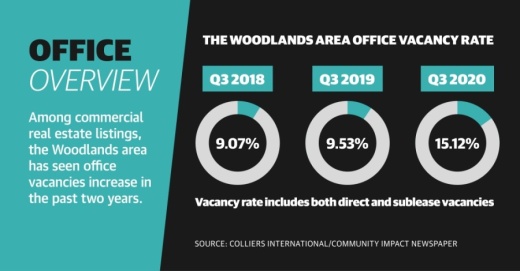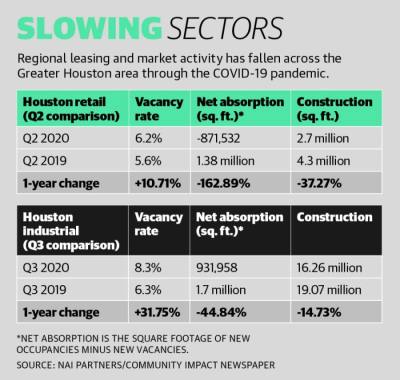In The Woodlands area, where office spaces have historically seen lower vacancy rates and greater resiliency than the Greater Houston region at large, challenges in filling that space could persist as the Greater Houston-area economy works to replenish 200,000 jobs lost this year, said Patrick Jankowski, the senior vice president of research with the Greater Houston Partnership.
“The main thing is it will take us [at least] three years to get back the jobs we’ve lost,” Jankowski said. “We might add back a few thousand oil and gas jobs, but since December 2014 we’ve lost over 90,000.”
With the growing amount of available commercial space and no immediate signs of job recovery, Jankowski said tenants are getting better deals on higher-quality office space, which helps areas such as The Woodlands, where strong demand was beginning to shrink before the pandemic.
“If you’re a tenant, this is a great time to be a tenant; if you’re a landlord, it’s a horrible time to be a landlord,” he said.
Challenges to resilience
While local experts and leasing agents have noted The Woodlands area’s resilience, this year’s downturn has nonetheless affected commercial leasing in south Montgomery County.
Based on information from real estate agency Colliers International, total office vacancy in The Woodlands submarket hovered around or below the 10% mark since early 2018. However, the area’s overall office vacancy rate began to tick upward this year and reached more than 15% in the third quarter.
The trend also can be seen in Class A offices. The highest of the three subjective grades used to describe the quality of commercial properties, Class A buildings typically have desirable locations and higher lease rates. The Woodlands is home to nearly 13% of the region’s Class A offices, according to Colliers.
Gil Staley, the president of The Woodlands Area Economic Development Partnership, said The Woodlands-area office market continues to outperform comparable Class A markets, and the 12.9% third-quarter Class A vacancy rate reported in The Woodlands this year by Colliers remains well below the Greater Houston area’s suburban office vacancy average of 22.5%. However, The Woodlands-area vacancies have risen by more than 40% since the third quarter of 2019.
“It’s not a [vacancy] number that we enjoy, but it’s better than what we’re seeing in the entire Houston region, so that makes us rather unique in office space vacancy,” Staley said.
Staley said in an October presentation to The Woodlands Township board of directors that recent occupancy gains included human resources company Alight Solutions’ expansion to a 180,000-square-foot office on New Trails Drive in March, as well as the recent lease of Western Midstream in the top five floors of The Woodlands Towers at the Waterway in the first quarter this year. Howard Hughes, which acquired the towers from Occidential Petroleum, also plans to relocate its consolidated corporate headquarters to one of the towers this year.
Trey Halberdier, the founder of The Woodlands-based Halberdier Real Estate, said some characteristics of The Woodlands community are unique within the Greater Houston market and can potentially add to its appeal for prospective tenants.
“If you’re an office building out on the freeway by itself with no amenities, you’re probably going to be struggling versus one of these whole-living concepts,” he said.
Jankowski said one reason Class A buildings maintain tenants is the “flight to quality.” Owners of Class A buildings try to stay leased by offering deals to entice Class B renters.
The Howard Hughes Corp., the developer of The Woodlands master-planned community, owns about a dozen Class A spaces in the Town Center and Hughes Landing areas.
Jim Carman, Howard Hughes’ Houston region president, said the company believes the area is poised to maintain its place in the market and bring in new business even in an idling market.
Despite the recorded dips in the retail and office sectors, commercial real estate companies in the market said industrial spaces fared better.
Halberdier said changes in supply chains over recent months due to increased online ordering gave industrial spaces a “shot in the arm.”
Jeff Beard, the president of The Woodlands commercial firm The J. Beard Real Estate Co., said medical office and industrial spaces, including warehouse properties, were also among the year’s strongest performers. According to Colliers, industrial vacancy in The Woodlands and Conroe market did not increase from the first to third quarters this year, while the regional rate rose more than 7%.
The Woodlands-area industrial market also benefited from the national ramp-up in the production of medical supplies this year with the arrival of a new personal protective equipment manufacturer.
During Staley’s October report, he said the arrival of Wildcat PPE in eastern College Park filled hundreds of long-vacant square feet of industrial space and brought hundreds of jobs to the area.
Regional market woes
With many companies opting to shift to remote working or downsizing, 2020 data across the Greater Houston area shows increasing office vacancy rates and a decline of more than 600,000 square feet in office net absorption—a figure that compares space vacated and space occupied over a given time.
According to data from Colliers International, the Greater Houston region’s office vacancy rate rose by 2% from the fourth quarter of 2019 to the third quarter this year. The first three quarters of 2020 saw absorption rates decrease throughout Greater Houston’s office market, meaning more office space was left vacant than occupied.
The energy-related workforce has contracted by almost a third since the end of 2014, and because it was one of the prime leasers of office space in the Houston area, that contributed to the office glut, Jankowski said.
Joe Bright, a senior associate with NAI Partners, a commercial real estate agency in Houston, said this year’s declines in regional office leasing follow around five years of softer conditions—meaning a market that favors buyers—partially due to declining employee counts and office footprints in the oil and gas sector. Bright said the market even appeared to be reducing vacancy rates and subleases before hitting a wall due to changes related to COVID-19 this spring.
“Now, it’s just completely stagnant. There’s very little positive deal activity with so many folks not even using their offices,” Bright said.
Bright also highlighted the decreased head counts and in-person work at regional office spaces as a key reason why activity in the market has slowed rapidly this year.
“The fact that people aren’t in their offices right now is the biggest issue marketwide,” he said. “It seems like everybody’s waiting for coronavirus to be over and for the election to be over or maybe for the year to turn the page. There’s just very little positive momentum in deal flow.”
Other types of commercial properties saw fewer leases over recent months as well. Houston-area retail vacancies grew by more than 10% from the second quarter of 2019 to the second quarter of 2020, according to NAI data. Regional industrial vacancies jumped by more than 31% from the third quarter 2019 to this year’s third quarter.
Office prospects
While an increase in employees working from home has emptied offices nationwide this year, experts are unsure how this year’s shift may play into the market’s future.
Colliers International does not expect an office market rebound until at least late 2021, with regionwide vacancies that could remain above a balanced 12%-15% level for years to come, Colliers’ Houston President Patrick Duffy wrote in the firm’s third quarter market analysis.
Bright also said he anticipates a late 2021 or even 2022 return to in-person work and regular leasing activity in the Houston market.
And Halberdier said he believes new working trends adopted this year may prove to have longer legs in the area as other factors such as technology make remote working more accessible.
“I think it took COVID[-19] for it to really create the catalyst that this is a reality that executives and workers are going to be working in different spots in the normal hub,” Halberdier said.
The idea that people will shift to scenarios where they work from home is not likely to completely transform the market, however, Jankowski said.
“I think right now people are putting too much weight on the fact that we’ll all be working from home forever,” Jankowski said. “I think what’s going to happen is we’ll have a hybrid environment where we’ll spend some at home and some from the office.”
Carman said tenants at Howard Hughes-owned commercial spaces in The Woodlands and Greater Houston area have had mixed responses about returning to work, with many larger companies still opting to keep offices empty as of late October. However, he said employers are likely to revert to an in-person or adaptable standard in the future.
“Having a physical office space is critical to having company culture,” Carman said.
Beard also noted the unknown effects of COVID-19 on office, retail and industrial leasing, although some changes in tenants’ needs have already become apparent.
“It is widely anticipated that adaptations due to COVID-19, from working remotely to inner office social distancing, will change retail, office, medical, and industrial space requirements for many companies in the future,” he said in an email.
Staley said companies are anticipating an eventual full return to offices.
“The one thing that I hear over and over: ‘We’re all ready to get back to normalcy.’ Without fail, that’s everyone’s comment,” he said.







